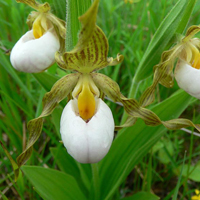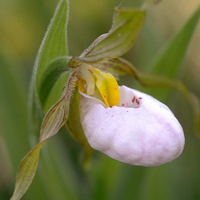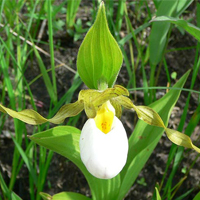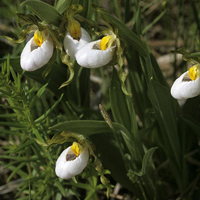Small white lady’s-slipper
Scientific name: Cypripedium candidum




Cover photos credit: Michael Oldham
Status
Endangered
“Endangered” means the species lives in the wild in Ontario but is facing imminent extinction or extirpation.
Date added to the Species at Risk in Ontario List
The Small White Lady’s-slipper was already assessed as endangered when the Endangered Species Act took effect in 2008. It was re assessed as endangered in 2015.
Read the report (PDF)
What it looks like
Small White Lady’s-slipper is a perennial orchid that grows up to 25 centimetres high. The mostly white flowers bloom in May and early June and look like a small slipper.
Fruit capsules form in June and July. The fruit opens up in September and October and releases thousands of tiny seeds.
Where it lives
In Ontario, Small White Lady’s-slipper grows in moist prairies, savannahs, and rich calcareous (limestone) wetlands, known as fens. This plant does best in full sunlight conditions.
Where it’s been found in Ontario
The range of the Small White Lady’s-slipper extends from southern Ontario and New York state, west to southern Manitoba and Saskatchewan, and south through the United States midwest to Missouri and Kentucky.
In Canada, it is limited to isolated populations in southern Ontario and southern Manitoba. The Small White Lady’s-slipper has disappeared from Saskatchewan and from the Bruce, Kent, Norfolk and Welland counties of Ontario; some plants are still found in Lambton and Hastings counties in Ontario.
There are seven populations of Small White Lady’s-slipper remaining in Ontario with a total of about 14,600 plants.
What threatens it
The primary threat to Small White Lady’s-slipper is habitat loss and degradation mainly due to development.
Alteration of hydrology through draining of sites, competition from invasive species, and the possible illegal collection of these showy plants are also significant threats.
The control of wildfires also allows shade-producing plants and bushes to take over open prairie areas, producing shady conditions detrimental to the lady’s slipper.
Action we are taking
Endangered Species and their general habitat are automatically protected
Recovery strategy
A recovery strategy advises the ministry on ways to ensure healthy numbers of the species return to Ontario.
Read the Executive Summary and Full Document (January 19, 2016)
Government response statement
A government response statement outlines the actions the government intends to take or support to help recover the species.
Read the government response statement (October 28, 2016)
Review of progress
A review of progress made toward protecting and recovering a species is required no later than the time specified in the species’ government response statement, or not later than five years after the government response statement is published if no time is specified.
Read the report on progress towards the protection and recovery of 18 species at risk, including Small White Lady’s-slipper (2021).
Habitat protection
General Habitat Protection - June 30, 2008
What you can do
Report a sighting
- Report a sighting of an endangered animal or plant to the Natural Heritage Information Centre. Photographs with specific locations or mapping coordinates are always helpful.
Volunteer
- Volunteer with your local nature club or provincial park to participate in surveys or stewardship work focused on species at risk.
Be a good steward
- Private land owners have a very important role to play in species recovery. If you find Small White Lady’s-slipper on your land, you may be eligible for stewardship programs that support the protection and recovery of species at risk and their habitats.
- Invasive species seriously threaten many of Ontario’s species at risk. To learn what you can do to help reduce the threat of invasive species, visit:
www.ontario.ca/invasivespecies
www.invadingspecies.com
www.ontarioinvasiveplants.ca - Small White Lady’s-slipper and many other species at risk depend on healthy grassland prairies, a rare habitat in Ontario. Learn more about these habitats, the species that depend on them, and what you can do to help at:
www.tallgrassontario.org. - Pollinators, such as bees, are in steep decline across the globe and they play a key role in the survival of many of Ontario’s rare plants. For information on how you can help scientists monitor pollinator populations in Ontario visit:
www.seeds.ca/proj/poll. - The Carolinian forests of southern Ontario support an amazing diversity of plants and wildlife, including many species at risk. Carolinian Canada is working to help recover species at risk and their habitats. For more information, visit:
carolinian.org/legacy/SpeciesHabitats.htm
Report illegal activity
- Report any illegal activity related to plants and wildlife to
1-877-TIP-SMNR (847-7667) .
Quick facts
- As with all orchids, Small White Lady’s-slipper and fungus found in the soil are interdependent for their nourishment and survival.
- Individual Small White Lady’s-slipper plants may not flower until as many as 16 years after germination.
- The fine, small seeds of Small White Lady’s-slipper are dispersed by wind.